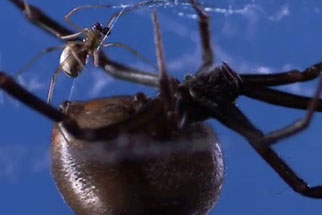Sexual Cannibalism
- Posted 05.13.09
- NOVA scienceNOW
In this audio feature, hear biologist Maydianne Andrade explain how sexual cannibalism–a gruesome mating behavior seen in Australian Redback Spiders–is a prime example of how evolution works.
 Listen
Listen
Biologist Maydianne Andrade says that the gruesome mating behavior of some spiders is a lesson in evolution.
Transcript
Sexual Cannibalism
Posted: May 13, 2009
DAVID LEVIN: You're listening to a NOVA scienceNOW podcast. I'm David Levin.
MAYDIANNE ANDRADE: What I was doing was essentially crawling around in the dirt (laughs)–I'd be looking for males; I'd be looking for females. And basically, peering into their lives.
DAVID LEVIN: Yeah… this is not as creepy as it sounds. Promise.
MAYDIANNE ANDRADE: When I first started as a graduate student the first task was to find good field sites–places where there was a large population of these Redback spiders. And my goal was to basically be an eavesdropper, or a voyeur. I was going to go out there at night, which is when they are most active, and see what they did.
DAVID LEVIN: That's Maydianne Andrade–she studies the behavior of Redback spiders. They're a close relative to the Black Widows that are here in the States.
MAYDIANNE ANDRADE: So the thing about the Redbacks is that they do have pretty dangerous venom. It's a neurotoxin. As the venom spreads, you'll experience muscle contractions which can be very painful–it can cause vomiting, diarrhea, fever, chills. I've spoken to people in Australia who had effects a year after being envenomated; they said that area of the body would periodically go numb.
DAVID LEVIN: So working with them can be tricky. But Andrade says they could shed some light on a gruesome mating behavior. It's called “sexual cannibalism”, and it's more or less what it sounds like. You see, these spiders don't just mate and go on their way. When a male finally does connect with a female, she eats him. While they're mating.
MAYDIANNE ANDRADE: The male will insert in the female, and then he'll flip and basically do a somersault. And that somersault takes him to a position where his body is immediately above her fangs. And she'll actually pierce him and begin to chew up parts of his abdomen. Now, what's really amazing about Redbacks is that this doesn't kill the male immediately. The male will continue to mate with the female while she's eating him. After being partly consumed, this male will actually pull himself free of the female, go back on the web, court her again, and then she kills him during that second copulation.
DAVID LEVIN: You're probably thinking, “this is a rough deal for the male”. And, in some ways, it is. But that's looking at this through human eyes. In the big picture–and I mean evolution–Andrade says this final, suicidal gesture is really an advantage.
MAYDIANNE ANDRADE: For Redbacks, if a female eats the male, she actually lets him mate for longer. And that means that he transfers more sperm, and he'll have more babies. So a male is throwing himself into the jaws of death, literally, in order to have more offspring. That's the currency that's important in evolution. And a male who has a thousand more offspring than his competitors–that trait is going to go on into the next generation.
DAVID LEVIN: Andrade says that's evolution at work. And what these spiders show is that the name of the game isn't always survival.
MAYDIANNE ANDRADE: A lot of people think that evolution is ‘survival of the fittest,’ which is a term that was coined ages ago–not by Darwin–and really doesn't describe how evolution works at all. Survival–in evolutionary terms–is important only insofar as it allows you to reproduce. Reproduction is what it's all about. So, this is a really good example of how, in one system, at least, males can actually do better if they mate only once and allow themselves to be killed.
DAVID LEVIN: So from a male Redback's point of view, going into the jaws of his mate–not once, but twice–is exactly the way he wants it.
MAYDIANNE ANDRADE: We don't know if spiders have a mental life, the extent to which they can think about or anticipate anything. By any sort of definition of it, the male has already experienced what's going to happen. [Laughs] He goes away, and then he comes back for more. And so, if there's a cognition or thinking involved with it, it should be, “This is perfect! It's all working out according to plan!”
Credits
Audio Credits
- Produced by
- Susan K. Lewis and David Levin
- Interview by
- Gary Johnstone
Images
- Image composite: (Maydianne Andrade)
- Courtesy Maydianne Andrade
- (redback spiders)
- © WGBH Educational Foundation
Related Links
-

Spider Woman
Maydianne Andrade explains the allure of her poisonous subjects, why spider research is important, and much more.
-

Creature Courtship
Why do males expend such time and energy to find a mate? Because of a little force of nature known as sexual selection.
-

Hear From the Spider Woman
Listen in as Maydianne Andrade describes tracking spiders in the wild, why her work is like basketball, and more.
You need the Flash Player plug-in to view this content.



